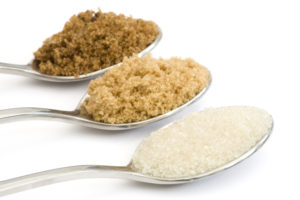One trip down the baking aisle in the grocery store and it’s easy to be overwhelmed by the various sugar options available. How do you know which one to choose? Here’s a quick Sugar 101 to help you make the right choice.
Sugar 101
Sugar is made from sugar cane, a large, tropical grass, and from the root of the sugar beet. The cane or beet are crushed and the juices that result are mixed with water, boiled and then crystallized.The crystallized sugar is raw sugar. Molasses is the liquid that remains after the sugar’s crystallized.
The raw sugar is steamed to remove any impurities that remain and the resulting sugar is turbinado (or demerara) sugar. Turbinado sugar is light brown with large, coarse crystals. It’s used frequently in drinks, but should not be substituted for granulated or brown sugar.
Turbinado sugar is heated, filtered and chemicals are used to purify it further. This clear liquid sugar is recrystallized again to produce granulated sugar.
Brown Sugar is granulated sugar with molasses added back to it. Dark brown sugar is darker in color and richer in flavor because it has more molasses in it than light brown sugar.
Powdered Sugar is made by grinding granulated sugar into powdered form. Cornstarch is sometimes added to powdered sugar to keep it from clumping. It’s also known as confectioners sugar, 10x or sometimes icing sugar.
Superfine or castor sugar is simply a smaller-grained granulated sugar. You can make superfine sugar by processing granulated sugar in a food processor.
Sugar cubes are made by moistening granulated sugar and pressing it into molds. It usually used in beverages.
Sanding sugar has large, coarse crystals that don’t dissolve easily, making it perfect for decorating cookies and other desserts.






Be the first to comment